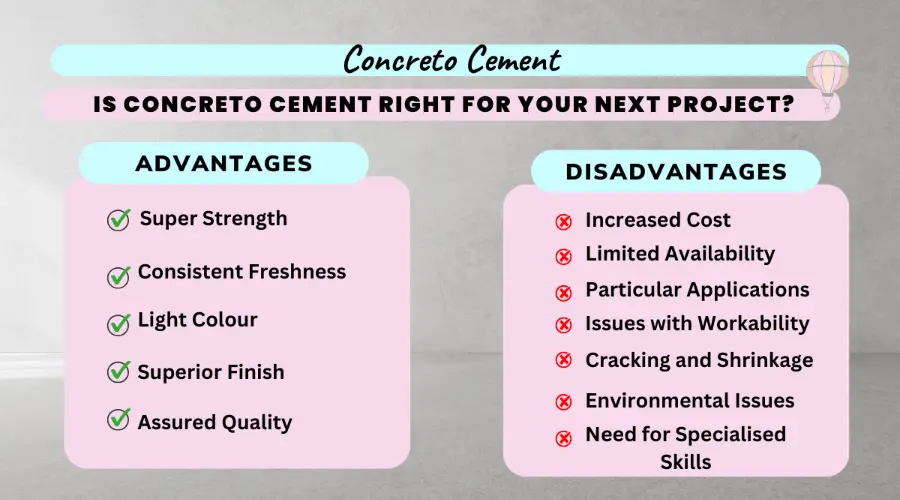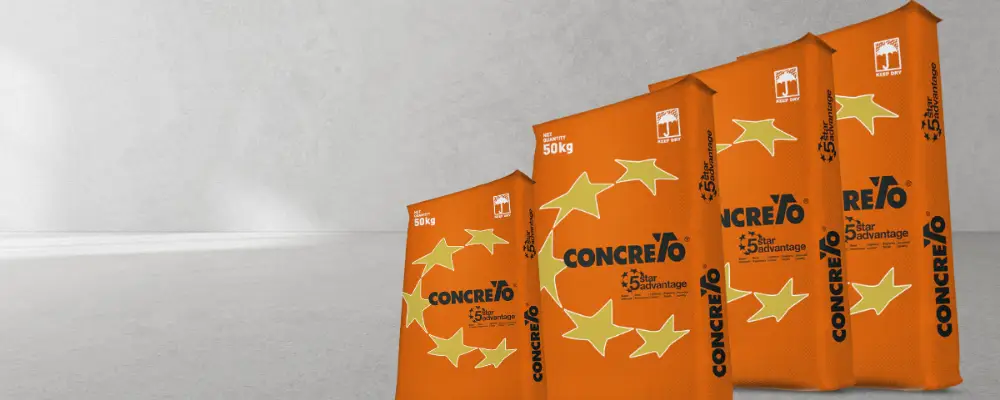A vast array of building materials are available to the construction industry to aid in the process. Concreto cement is a specialised type of slag cement that is recognized for its effectiveness in various construction projects. Its strength, resilience, and chemical resistance are increased by the combination of cement with granulated blast furnace slag. When compared to conventional solutions, the cement’s premium attribute shows that it provides greater quality and performance. As concreto cement is used for various applications and purposes, it is crucial to know its advantages and disadvantages for better understanding.
What is Concreto Cement?
Concreto cement is a multipurpose, premium slag cement that can be us
ed for numerous types of construction projects. Massive construction undertakings like bridges or industrial structures, as well as small-scale ventures like commercial buildings and residential spaces, can all benefit from the usage of concreto cement. Because it ensures smoother and more aesthetically pleasing surfaces both inside and outside the building, this cement is a popular material for architectural and decorative purposes. Concreto cement is a highly reliable and superior option for a diverse range of building requirements.
When Concreto cement, made with slag, replaces regular cement, it forms a denser concrete mix. The finer particles of slag fill small gaps and pores, resulting in a tightly packed structure with fewer voids. This denser mix enhances the concrete’s strength, reduces water and chemical permeability, and makes structures more durable. As a result, buildings made with Concreto cement are more resistant to corrosion and cracking, require less maintenance, and last longer.
Applications of Concreto Cement
The various applications of concreto cement are as follows:
- Roofing
Concreto cement is well-suited for creating strong, long-lasting roofs that can withstand harsh weather, including heavy rain, intense sunlight, and wind. Because of its dense composition, there is less chance of water absorption, which lowers the possibility of leaks and preserves the roof’s structural integrity over time. It offers a sturdy foundation for tiles or waterproofing layers and is appropriate for both flat and inclined roofing applications.
- Foundations
Any construction starts with a foundation, and Concreto’s denser mix provides increased strength and longevity. Even with heavy loads or difficult soil conditions, its impressive compressive strength guarantees stability and keeps it from splitting or settling. Concreto’s chemical resistance aids in shielding foundations from corrosive factors such as salty and soil moisture.
- Beams and Columns
The structural stability of a structure depends on these load-bearing elements. Because of the strength of concreto cement, beams and columns can support heavy loads and withstand stress without breaking or deforming. Due to its thick mix, there are fewer voids and air pockets, which lowers the possibility of these crucial structural components becoming weak.
- Plastering
Concreto is ideal for plastering since it gives walls and ceilings a smooth, non-cracking finish. Its tiny particle size makes the application simple and guarantees a smooth, high-quality surface that improves the building’s visual attractiveness. Additionally, the dense mix lowers porosity, strengthening the plastered surface’s resistance to weathering and moisture.
- Brickwork
Long-lasting performance is guaranteed by the chemical resistance, even in damp or polluted conditions. Its high bonding strength reduces the risk of cracks and gaps in brick walls. The chemical resistance ensures long-lasting performance, even in environments exposed to moisture or pollutants.
How to Use Concreto Cement in Construction?
Effective use of concreto cement in buildings requires careful planning and adherence to industry best practices to ensure longevity and strength. Here is a concise guide:
Determine the Use Case
For high-strength projects like roads, bridges, high-rises, precast parts, and foundations, use concreto cement.
Select the Proper Mix
Use appropriate admixtures if necessary, modify the water-to-cement ratio for workability, and follow the manufacturer’s mix instructions.
Get the site and materials ready
Make sure the water, aggregates, sand, and cement are of high quality. Accurately measure ingredients and store cement in a dry location.
Mix Well
Utilize a mechanical mixer to achieve a uniform consistency; add cement, sand, aggregates, and water, then mix thoroughly.
Pour and Set Aside Quickly
Quickly transport the concrete to the formwork, then use vibrators to crush it and eliminate any air bubbles.
Cure the Concrete
Use water sprays, curing agents, or wet covers to begin curing within 24 hours and maintain moisture for 7–14 days.
Observe Safety Precautions
Proper ventilation is essential in the workspace, and skilled workers must wear safety gear such as masks, gloves, and goggles.
Verify Quality
Check for cracks during the curing process at 7, 14, and 28-day intervals, and conduct compressive strength tests at these stages.
Put the finishing touches on
For exposed surfaces, apply sealants or protective coatings, and make sure pavement joints are spaced properly.
Top Techniques
For large projects, maintain controlled environmental conditions, use clean water, and avoid adding water once the setting begins.

Advantages of Using Concreto Cement
The unique quality and properties of this product set it apart from others. It enhances longevity by addressing issues related to cracks. The advantages of using concreto cement include:
- Super Strength
Because of its remarkable compressive strength, concreto cement is perfect for heavy-duty constructions including foundations, beams, and columns. Even in difficult circumstances, stability and longevity are guaranteed by its sturdy formulation.
- Consistent Freshness
The cement retains its freshness throughout storage and application, guaranteeing reliable results. This characteristic improves construction process efficiency and lowers the chance of early setting.
- Light Colour
Its light color makes plastered surfaces appear brighter and more elegant, reducing the need for extra paint and enhancing the overall aesthetic appeal.
- Superior Finish
Concreto Cement provides long-lasting, aesthetically beautiful finishes for both external and interior surfaces, ensuring walls are smooth and free of cracks.
- Assured Quality
Concreto cement is used extensively for many different purposes, so you can be confident that its quality will always be guaranteed.
Disadvantages of Using Concreto Cement
- Increased Cost
Because of its superior properties, like increased strength and durability, concreto cement is often more costly than ordinary Portland cement (OPC).
- Limited Availability
Compared to more popular varieties of cement, it could not be easily accessible in all locations, which could cause delays or raise procurement prices.
- Particular Applications
Although concreto cement is great for certain uses, such as high-strength pavements, roads, or structures, it might be unnecessary or cost-effective for less demanding projects, like modest residential buildings.
- Unsuitability for Specific Admixtures
Concreto cement might not perform well with all types of admixtures, potentially limiting the flexibility of the mix design.
- Issues with Workability
Concrete made using high-strength cement, such as concreto cement, may become less workable, particularly if it is not properly built or combined with the right additives for optimal handling and flow.
- Cracking and Shrinkage
The high cement content and quick setting of concreto cement can cause it to shrink and crack if it is not cured properly.
- Need for Specialised Skills
Concreto cement construction may necessitate professional labour to ensure correct mixing, laying, and curing, which could raise labour expenses.
- Environmental Issues
Producing concreto cement uses a lot of energy and releases more CO2 than other types of cement.
Conclusion
Concreto Cement improves the visual attractiveness of both exterior and interior surfaces through its smooth finish and fine texture. It is also ideal for constructions exposed to adverse conditions due to its exceptional resistance to weather and chemical elements, which offers long-term protection. Concreto cement provides great value for money by combining high performance with cost-effectiveness, ensuring better construction quality and reducing future maintenance costs.
FAQ’s
Yes, because of its exceptional strength, durability, and adaptability, concreto cement is a great option for building projects.
Concreto cement is not completely waterproof, despite having improved moisture and water resistance which makes it perfect for usage in damp conditions. Nonetheless, it considerably lowers the possibility of water intrusion, enhancing the structure’s overall resilience.

